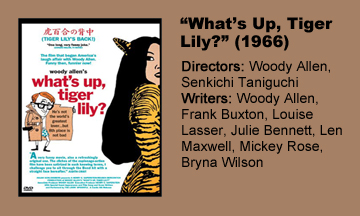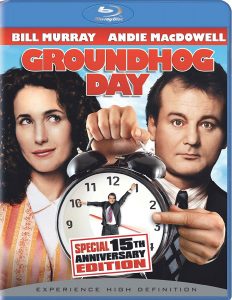Woody Allen makes a creative directorial debut (he was only the writer on his previous credit, 1965’s “What’s New Pussycat?”) with “What’s Up, Tiger Lily?” (1966), a comedy in a riffing style that presages “Mystery Science Theatre 3000” (1988-2015).
Allen and his co-writers take the Japanese James Bond knockoff “Key of Keys” (1965) and pen new dialog that forms a purposely ridiculous and nonsensical spy-action spoof while also making fun of the shoddy original material.
Short, yet too long
Seventy-nine minutes is short for a film, but it’s too long for this particular one, although that’s not Allen’s fault. His cut was an hour long, and then the studio padded it out with unconnected performances by Lovin’ Spoonful, which provides “Tiger Lily’s” earworm that’s ubiquitous in the transitional scenes.

The hour point was when I had about enough of this, which suggests Allen had an early sense for audience attention spans, likely using his own sense of what’s funny and for how long.
Allen and his six co-writers – plus a talented and game cast of voice actors – have more fun with this concept than I do, but “Tiger Lily” is a notch above doing homework.
It falls somewhere in quality between “Batman” (1966) and “Airplane!” (another film that purchased an straight movie in order to build a comedy out of it, although in that case everything is re-shot, not merely dubbed).
It also presages those later Zucker Brothers hits with a credits gag – instead of credits (of which this film doesn’t have many), it chastises the viewer for reading the text on the right instead of watching the striptease on the left. (Then Allen steps in to say he promised this actress a spot in the film, a jab at shady casting practices long before such things were widely known.)
Executing the concept
Critically speaking, it’s impressive how “Tiger Lily” builds a narrative – to the degree it does — about rival spy organizations and a Bond-like hero only through dialog. That doesn’t mean anyone is watching it for the story. Halfway through the film, we cut to an interviewer asking Allen to give a recap of the convoluted yarn so far, and Allen simply says “No.”
The humor lands – again, to the degree it can – a good percentage of the time. A safe-cracking scene where everyone is wearing gas masks and apparently having long conversations allows for one character to do impressions of celebrities.
At another point, they reverse a sequence of people jumping on to a boat so they are now fleeing from a rat on the boat. Even the just-plain-goofy bits, like a voice actor doing a ridiculous sinister laugh for a henchman, had me chuckling at times.
This comedy is conceptually clever and intermittently funny, and no one could come away from this saying Allen doesn’t have a sense of humor. Aside from being too long by studio mandate, the downside of “What’s Up, Tiger Lilly?” is that it’s simple.

Even if it is ahead of its time, it’s still just an episode of “MST3K.” Therefore, it’s for people who love riff comedy or for nerdy Allen scholars; everyone else should watch Allen’s masterpieces first.

